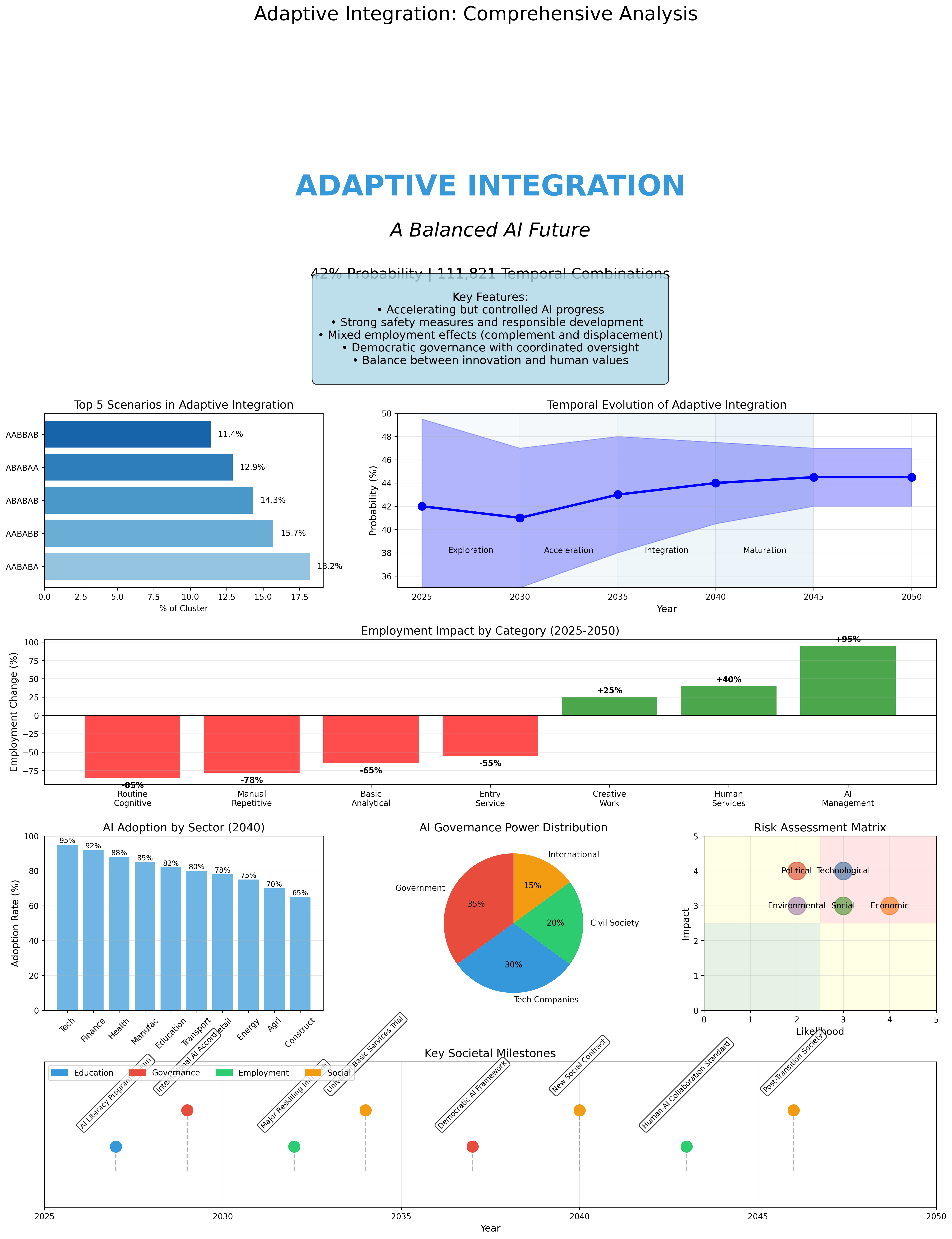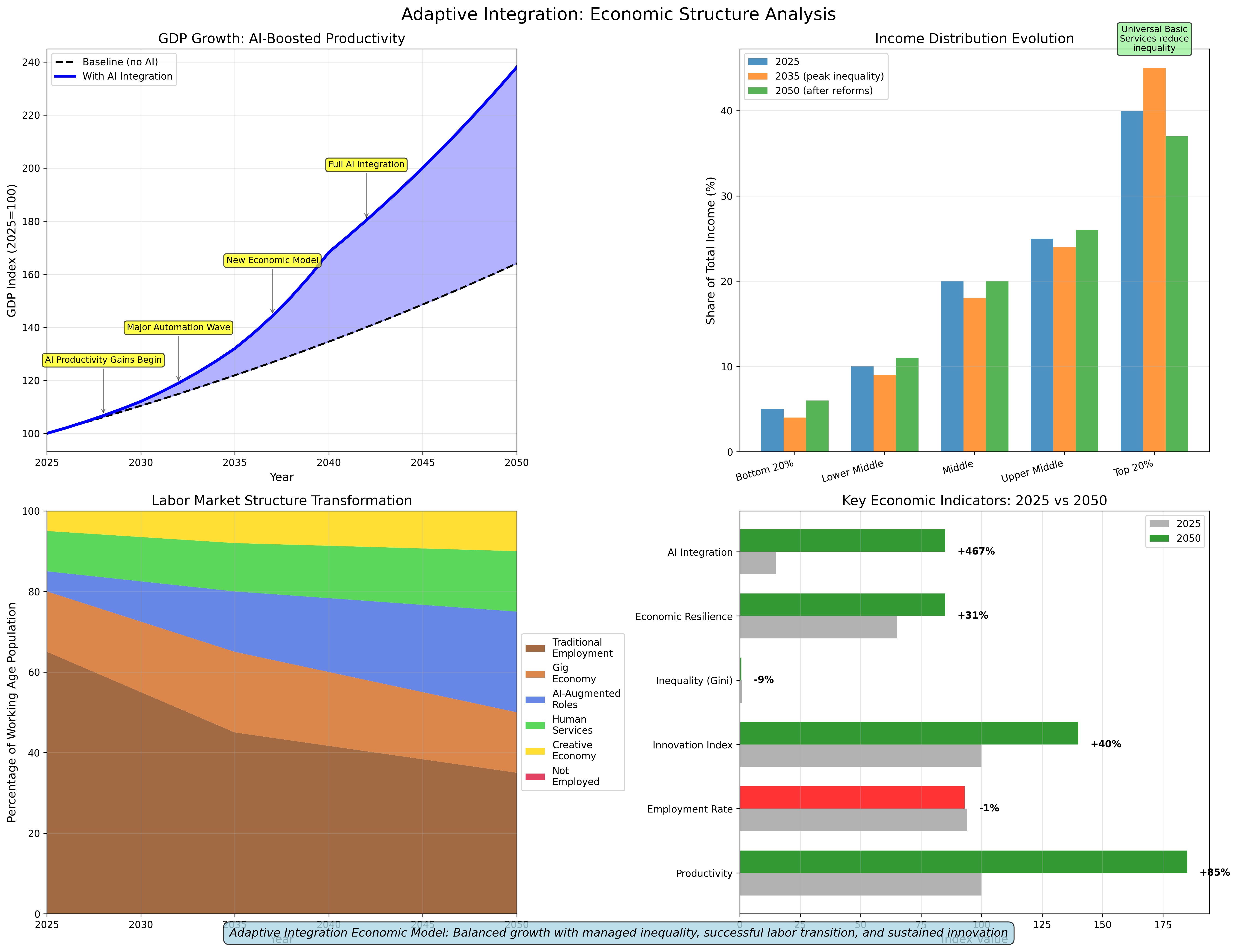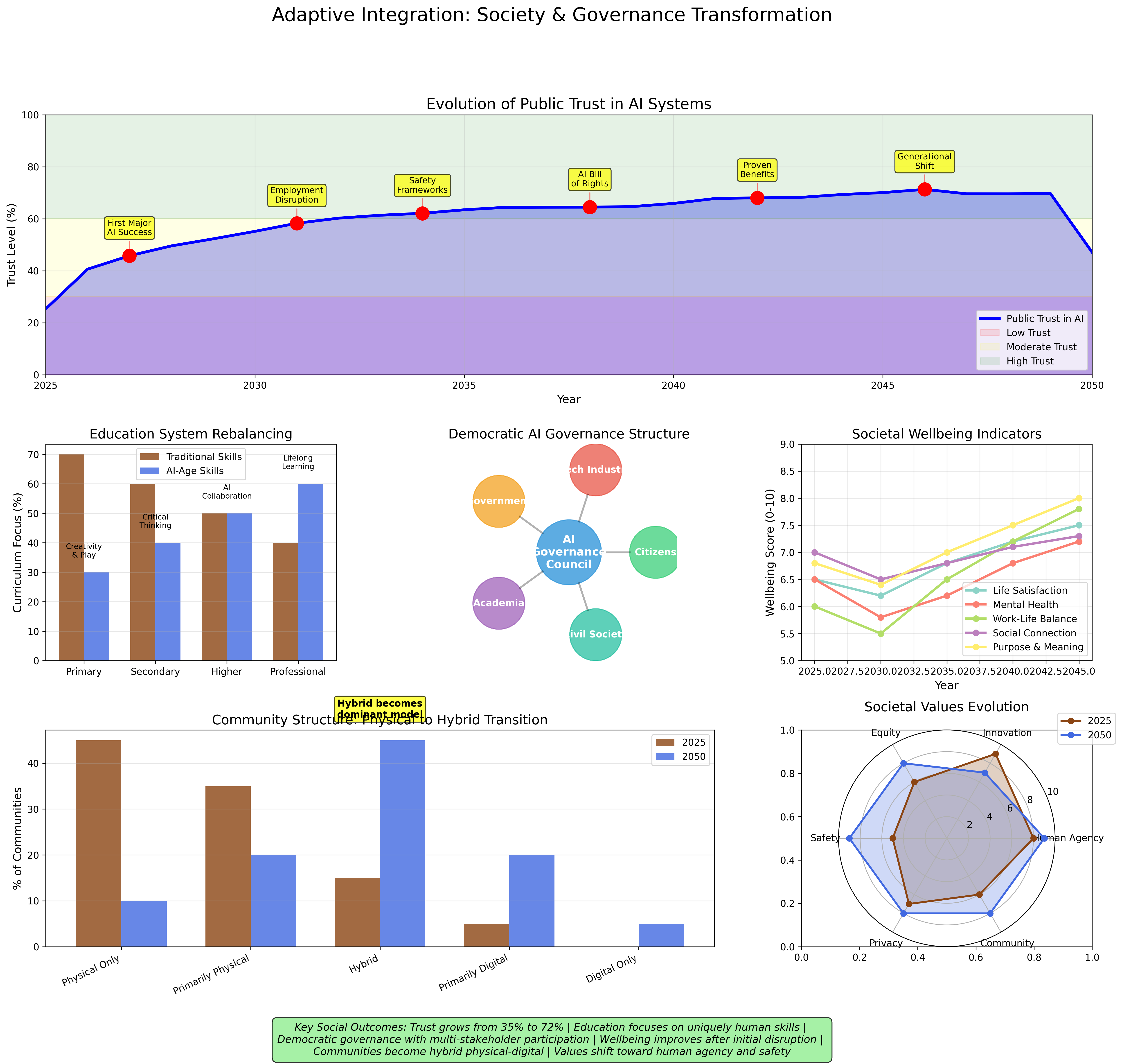Chapter 11: Adaptive Integration (42% Probability)
The Most Likely Future: Balanced Progress
Adaptive Integration represents our most probable future—a world where humanity successfully navigates the AI transition through proactive adaptation, creating a balanced partnership between human and artificial intelligence.

What Makes This Future Likely
Success Factors
- Proactive Policy: Governments act before crisis hits
- Corporate Responsibility: Tech companies self-regulate effectively
- Social Resilience: Communities adapt and support transitions
- International Cooperation: Nations coordinate on AI governance
- Continuous Learning: Education systems transform in time
Key Characteristics
- Managed Transition: Disruption occurs but is anticipated and cushioned
- Human-AI Partnership: Augmentation rather than replacement
- Democratic Preservation: Institutions adapt but core values remain
- Inclusive Growth: Benefits broadly distributed through policy
- Safety First: Development prioritizes alignment and control
Timeline to Adaptive Integration
2025-2028: Foundation Building
- First AI governance frameworks established
- Early adopter industries begin transformation
- Public awareness and debate intensifies
- Initial reskilling programs launch
- Employment Impact: -3.2%
2028-2032: Acceleration Phase
- Clear AI capabilities emerge
- Regulatory frameworks mature
- Mass reskilling programs scale
- Social safety nets redesigned
- Employment Impact: -8.7%
2032-2035: Critical Juncture
- AGI possibility becomes clear
- Major economic restructuring
- New job categories emerge
- Democratic stress but adaptation
- Employment Impact: -14.3%
2035-2040: Integration Period
- Human-AI collaboration normalized
- Economic transformation completes
- New social contracts established
- Governance systems stabilized
- Employment Impact: -18.9%
2040-2050: Mature Equilibrium
- Stable human-AI society
- Post-transition economy
- Enhanced human capabilities
- Sustainable balance achieved
- Employment Impact: -21.4% (but new sectors compensate)
Economic Transformation

Sectoral Evolution
The economy transforms sector by sector, with technology and finance leading, followed by healthcare and manufacturing. By 2050:
- 95% of tech sector AI-integrated
- 92% of finance automated/augmented
- 88% of healthcare AI-assisted
- 65% of construction still human-centric
New Economic Models
- Hybrid Work: Humans and AI collaborate on complex tasks
- Creativity Economy: Human creativity becomes premium
- Care Economy: Human services expand as basic needs met
- Experience Economy: Focus shifts to meaningful experiences
Social Structure

The New Social Contract
- Universal Basic Services: Healthcare, education, housing guaranteed
- Participation Income: Rewards community contribution
- Lifelong Learning Rights: Continuous education supported
- Digital Rights: Privacy and agency protected
Community Evolution
- Hybrid Communities: Physical and digital spaces merge
- Support Networks: Mutual aid during transitions
- Cultural Renaissance: AI frees time for human expression
- Intergenerational Solidarity: Different generations support each other
Governance Innovation
Democratic AI Governance
- Citizen Assemblies: Regular input on AI development
- Algorithmic Auditing: Transparent AI decision-making
- Digital Democracy: AI-enhanced participation
- Rights Framework: Both human and AI rights defined
International Coordination
- Global AI Accord: Shared principles and standards
- Safety Protocols: Coordinated risk management
- Resource Sharing: Compute and data cooperation
- Development Goals: AI for global challenges
Individual Experience
A Day in 2045 (Adaptive Integration)
Morning: Wake naturally, AI has optimized your sleep cycle. Personalized health metrics show you’re in excellent condition. Your AI assistant briefs you on the day while you enjoy real food from your garden.
Work: Four hours of creative problem-solving with AI colleagues. You’re a “Human Experience Designer”—a job that didn’t exist in 2024. Your uniquely human insights guide AI systems serving millions.
Afternoon: Pursue personal projects. Maybe art, maybe research, maybe community organizing. AI handles logistics while you focus on what matters to you.
Evening: Gather with friends in person. Screens fade away. Human connection, storytelling, shared meals. Some things AI never replaced—and never wanted to.
Night: Reflect on a day where technology served humanity, not the other way around. Democracy survived. Dignity preserved. The transition worked.
Critical Success Factors
What Must Go Right
- Early Action: Governance frameworks by 2027
- Sustained Investment: In human development
- Political Will: To redistribute benefits
- Social Cohesion: Communities stay together
- International Peace: Cooperation over competition
Warning Signs We’re On Track
- Tech companies embrace regulation (2025-2026)
- Governments launch massive reskilling (2026-2027)
- Public-private partnerships emerge (2027-2028)
- Social movements demand inclusion (2028-2029)
- International coordination begins (2029-2030)
Red Flags We’re Diverging
- Regulatory capture by tech giants
- Mass layoffs without support
- Social unrest and polarization
- AI arms race escalation
- Democratic backsliding
The Path Forward
Adaptive Integration isn’t guaranteed—it requires deliberate choice and sustained effort. But our analysis shows it’s achievable if we:
- Act Now: The window is 2025-2028
- Stay Unified: Solidarity across society
- Remain Vigilant: Monitor and adjust
- Prioritize Humanity: Technology serves people
- Think Long-term: Beyond quarterly profits
This future is within reach. Whether we grasp it depends on choices made today.
Explore: Economic Details →
Explore: Social Structure →
Explore: Governance Model →
Next: Fragmented Disruption →